I’m making excellent progress on my brand-new concert piece for the Octava Chamber Orchestra set to be premiered by them this summer. Pretty soon, the only thing left will be the hardest thing to figure out of all: the name of the piece.
Working on this composition has also turned into kind of an exercise in balanced musical structure. Often, I let a composition grow organically into whatever shape it ends up in, and usually that works out fine. However, as I have been thinking a lot about form, as well as writing at length about it here on my blog – see my detailed explanation of Skule Overture if you haven’t already – it has been on top of mind while writing this new piece for Octava.
Another reason for my current obsession over form is that, as told in another recent post, this piece is based on an older one: a short study piece that, even back then, I felt had unfulfilled potential. It was fun and cute, though, and I remember the players also enjoyed it, but it was too short to be entirely rewarding. I didn’t develop the musical ideas enough. Because of the piece’s mandated short duration, there really wasn’t enough space (or time? Spacetime?) to do so.
I’ve had the old study piece as a kind of guilty conscience in the back of my head while working on this one, and as a result, I have been much more conscious about evaluating and re-evaluating the shape of the new piece, going back over earlier sections even as I focus on later ones.
Younger me rarely did this, but as a (somewhat) more seasoned composer I have not only realised but embraced the merits of looking back as well as forward during the composition process. I thought it would be worth taking a look in this blog post at how the first two sections of have grown, in stages.
First of all, here are the two principal motifs I have lifted from the old study piece and am basing this new piece on: one melodic and one rhythmic motif.


And this is the finished version of the new piece’s first two sections, in score reduction format:
The repeated rhythmic motif plucked by the strings is the foundation of the first section. On top of the strings, the flutes and clarinets play drawn-out hints of the melodic motif in quartal or quintal harmony. I realised after the fact that the harmonisation, in combination with the slow phrases, gives the first section a slight Joe Hisaishi-like flavour.
In the second section (starting in bar 57) the oboes and bassoons flesh out the melodic motif in a 10 bar four-part fugato, building to the first proper presentation of the melody with a poppy, homophonic harmonisation. One of the horns reinforce the melody, as it is actually the bottom part out of the four. Rounding out the second section is one more fugato (starting in bar 77), shorter and more condensed, this time with the flutes and clarinets.
I started working on these two sections in parallel, at the same time as I was sketching out later parts of the piece. I didn’t initially have a clear idea for how to connect the various sections, or how they should relate to and complement each other.
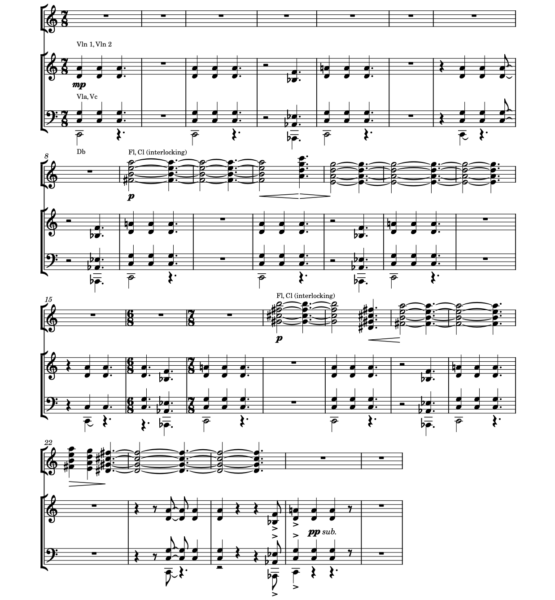
Initially, the first section was less than 30 bars long. Each repeat of the rhythmic motif (except the last) is exactly 8 bars. In the beginning, I also had the double basses play along from the start with regular entries. However, rather quickly I opted to instead use the basses more sparingly and add timpani as well, for a bit of added punch as well as additional colour.
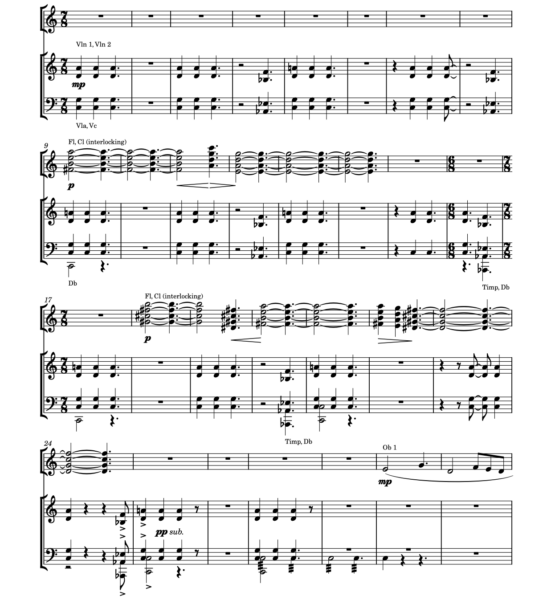
Later on, while working on joining the first two sections, the first section felt like it ended way too abruptly with just the the subito pianissimo in version 1. I tried adding only a timpani roll over another repeat of the rhythmic motif to smoothen the transition, which resulted in version 2 shown above, but I concluded not long after that it wasn’t enough.
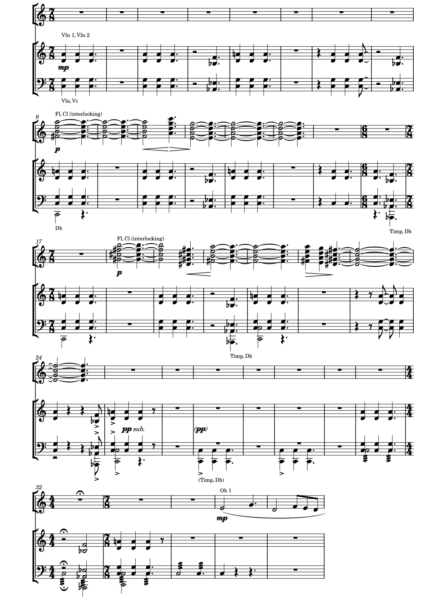
I had also been thinking about doing something with only timpani and double bass, so I tried extending the end of the first section with that idea resulting in version 3 as seen above. I kept working on several sections simultaneously, moving between them as I got new ideas for one or the other, but I never felt quite satisfied with section one.
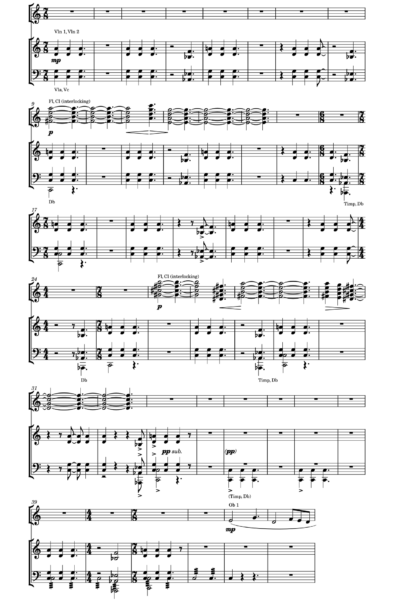
Later still, I added an eight-bar repeat in between the two flute/clarinet phrases to space them out a bit. This, becoming version 4 shown above, turned out a big improvement. I have heard this rhythmic motif to death by now, but the audience will not, so I should allow them some time to rest in this section before moving on.
This excellent progress however meant that now, the latter half of the first section felt imbalanced: I needed a third entry for the flutes and clarinets! For further variation, I decided on quintal harmony for this one, instead of quartal harmony which I used for the first two entries. The quintal harmonisation made the third entry stray the farthest out of all three from the strings’ implied harmony, so I chose to let them rest during the third woodwind entry.
After some further trial and error, I arrived at the finished first section that you can see in the embedded PDF higher up in the post. I also expanded the final statement of the rhythmic motif, as a counterweight to the new woodwind entry. The bassoon staccatos came up on a whim, to connect back to the pizzicato motif, since I omitted the rhythmic motif there.
What about the second section? Well, it only really had one previous iteration, ending with the oboes and bassoons’ homophonic setting of the melodic motif. I added the flutes and clarinets later because – again – as other sections grew, the second section felt too short. I did not want to a new phrase with the oboes and bassoons either, as they had come to what felt like a satisfying conclusion. (I also considered a different pairing of instruments altogether, but saved that for later.)
One last thing about the first section.
Perhaps you noticed I’m shifting the rhythmic motif around within the bars, as well as playing around a little with time signatures. I wanted to stave off monotony for the audience as well as the players, while still maintaining the motif’s simplicity. For a time, I experimented with having lots more time signature changes in the first section, at one point having wildly different endings to each eight-bar phrase. It only ever felt like I was trying too hard, though, and ultimately I just needed to relax a bit and keep things simple.
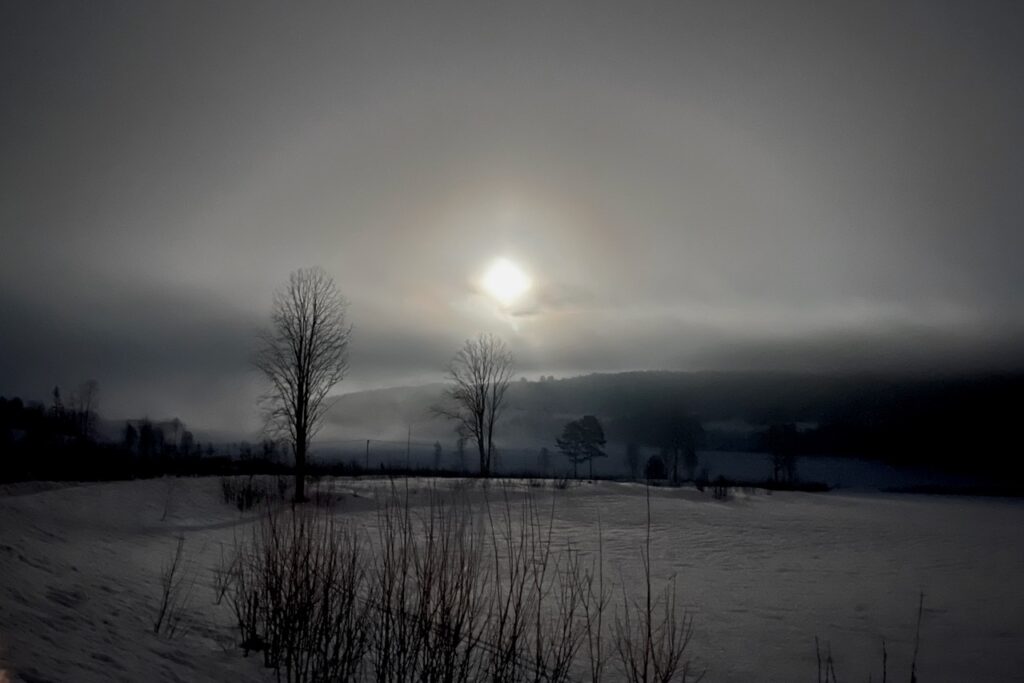
In a later post, I might discuss how I handled the two climaxes in the piece. Those are also difficult, I think. I find tutti passages distinctly more difficult to pull off well than smaller, more intimate ones. Honestly, that’s not surprising, as I’ve written quite a lot more chamber music than orchestral. It’s easy to just have everyone play a massive fortissimo, doubling parts all over the place, but that rarely (if ever) works out well.
Also, I still need to figure out a name, dammit.
